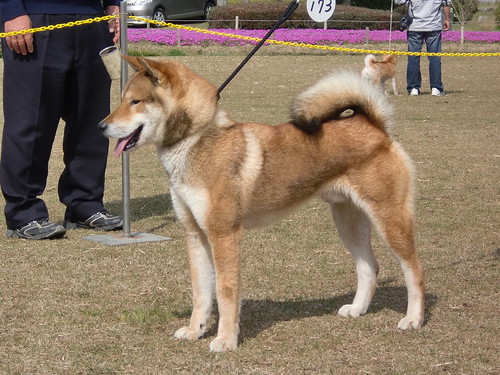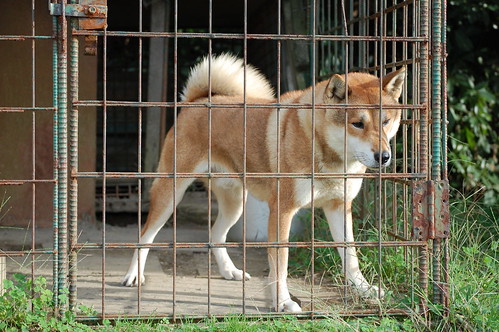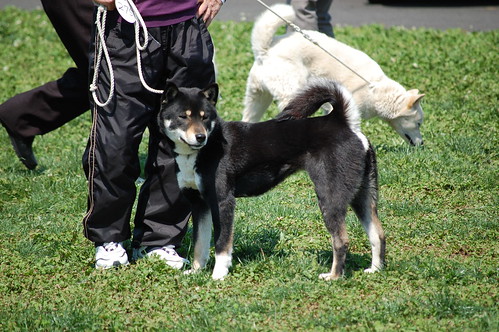The Shikoku
The Shikoku Ken is one of the six, native, Japanese sptiz-type dogs. Native to the mountainous region of Kochi prefecture on the island of Shikoku, these athletic and agile dogs are accomplished big game hunters and are sometimes referred to as the Kochi Ken. The Shikoku Ken is prized for it's tenacity in face of large game and their relative calm around the family. Originally known as the Tosa Ken, they were renamed so as not to be confused with the Tosa fighting dog.

An aka-goma Shikoku male
In post World War I Japan, the relative prosperity of the country succumbed to economic hardship as the Showa period began in 1926. Once relatively common, luxuries such as dog ownership became increasingly uncommon. In 1928, the Nihon Ken Hozonkai (NIPPO) was formed. NIPPO is an organization dedicated to the preservation of the six native Japanese spitz-type dogs. In 1937 NIPPO succeeded in having the Shikoku Ken declared a "Living Natural Monument" of Japan and a major reconstruction effort was undertaken.
Out of the reconstruction effort, three distinct lines of the Shikoku were developed: the Awa, the Hongawa and the Hata all named after the areas they originated from within Kochi prefecture. More recently the distinction between these lines has been blurred as remote areas where the dogs originated became easier to access and lines were cross bred. The modern Shikoku is thought to descend mainly from the Hongawa and Hata lines as the Awa line essentially disappeared as a result of the hardships caused by World War II and a lack of quality specimens due to cross breeding with outside dogs.

A kuro-goma Shikoku female
One of the foundation dogs of the Hata line was "Goma-gou," who was born in 1934. He obtained a Best in Show title in 1940. The principle elements of the Hata line included a generally heavier, stockier build and thicker, longer, and more profuse coats; skulls tended to be broader, ears tidier and smaller, and movement ponderous. Much of the Hongawa line is attributable to the foundation dog "Choushun-gou" who took Best in Show the following year and was also born in 1934. These dogs were characterized by light, flowing movement, long, strong limbs with excellent angulation, good ear set and correct eye colour. Their outer coats were harsh and weatherproof, but their protective undercoats did not match the quality of the Hata line's. Hongawa Shikoku also tended to be slender and have a more elegant build. Ultimately it was the Hongawa Shikoku that was to have the most influence on the direction of the breed as we know it today. Two other notable Shikoku from the same period are "Kusu-gou" who took Best in Show in 1939, and "Kuma-gou". These four dogs formed much of the foundation for the modern day Shikoku.

An aka Shikoku male
The Shikoku standard, as written today, describes them as: "A medium-sized dog with well balanced and well developed clean cut muscles. It has pricked ears and a curled or sickle tail. Conformation: strong, well-boned and compact." Dogs stand at 49-55cm and bitches at 46-52cm (NIPPO, JKC). There are four accepted coat colors in the standard: goma (sesame), aka (red), kuro (black), and shiro (white/cream). White is not desirable in the Shikoku and is penalized heavily in the conformation ring. For many years black was not popular with many breeders leading to the misconception that it is not desirable, however this is false. Many experienced Shikoku breeders in Japan will breed black Shikoku (especially males) to maintain darker colors and thicker coats in their blood lines. The black coloration was especially prevalent in the original Hongawa dogs. There are three types of goma (sesame): kuro-goma (more black than light colored hairs), aka-goma (red base with black hairs mixed in), and shiro-goma (white base with black hairs mixed in). Like all Nihon Ken, the Shikoku has a double coat made up of coarse outer guard hairs, and a thick fine undercoat that it sheds seasonally. All Shikoku should have "urajiro" markings which are markings of a white or cream color presented on the ventral portions of the body and legs, as well as on the cheeks and brow of the head.

A kuro Shikoku female
The Shikoku is more eager to please its owner than some of the other Nihon Ken, but is still an independent thinker and often will not listen or ignore commands. Shikoku can be territorial and make reasonable watch dogs, but are not by nature guard dogs or protection dogs. The Shikoku Ken is one of the rarest of the Nihon Ken. Only a small number are known to exist outside of Japan. Some estimates put this number around 100 (as of 2010). Even in Japan the breed is very rare with yearly registrations of 200-400. The number of Shikoku in Japan is estimated to be between 5000-7000. The main breed registry is run by the Nihon Ken Hozonkai (Nippo).

An aka-goma Shikoku male
In post World War I Japan, the relative prosperity of the country succumbed to economic hardship as the Showa period began in 1926. Once relatively common, luxuries such as dog ownership became increasingly uncommon. In 1928, the Nihon Ken Hozonkai (NIPPO) was formed. NIPPO is an organization dedicated to the preservation of the six native Japanese spitz-type dogs. In 1937 NIPPO succeeded in having the Shikoku Ken declared a "Living Natural Monument" of Japan and a major reconstruction effort was undertaken.
Out of the reconstruction effort, three distinct lines of the Shikoku were developed: the Awa, the Hongawa and the Hata all named after the areas they originated from within Kochi prefecture. More recently the distinction between these lines has been blurred as remote areas where the dogs originated became easier to access and lines were cross bred. The modern Shikoku is thought to descend mainly from the Hongawa and Hata lines as the Awa line essentially disappeared as a result of the hardships caused by World War II and a lack of quality specimens due to cross breeding with outside dogs.

A kuro-goma Shikoku female
One of the foundation dogs of the Hata line was "Goma-gou," who was born in 1934. He obtained a Best in Show title in 1940. The principle elements of the Hata line included a generally heavier, stockier build and thicker, longer, and more profuse coats; skulls tended to be broader, ears tidier and smaller, and movement ponderous. Much of the Hongawa line is attributable to the foundation dog "Choushun-gou" who took Best in Show the following year and was also born in 1934. These dogs were characterized by light, flowing movement, long, strong limbs with excellent angulation, good ear set and correct eye colour. Their outer coats were harsh and weatherproof, but their protective undercoats did not match the quality of the Hata line's. Hongawa Shikoku also tended to be slender and have a more elegant build. Ultimately it was the Hongawa Shikoku that was to have the most influence on the direction of the breed as we know it today. Two other notable Shikoku from the same period are "Kusu-gou" who took Best in Show in 1939, and "Kuma-gou". These four dogs formed much of the foundation for the modern day Shikoku.

An aka Shikoku male
The Shikoku standard, as written today, describes them as: "A medium-sized dog with well balanced and well developed clean cut muscles. It has pricked ears and a curled or sickle tail. Conformation: strong, well-boned and compact." Dogs stand at 49-55cm and bitches at 46-52cm (NIPPO, JKC). There are four accepted coat colors in the standard: goma (sesame), aka (red), kuro (black), and shiro (white/cream). White is not desirable in the Shikoku and is penalized heavily in the conformation ring. For many years black was not popular with many breeders leading to the misconception that it is not desirable, however this is false. Many experienced Shikoku breeders in Japan will breed black Shikoku (especially males) to maintain darker colors and thicker coats in their blood lines. The black coloration was especially prevalent in the original Hongawa dogs. There are three types of goma (sesame): kuro-goma (more black than light colored hairs), aka-goma (red base with black hairs mixed in), and shiro-goma (white base with black hairs mixed in). Like all Nihon Ken, the Shikoku has a double coat made up of coarse outer guard hairs, and a thick fine undercoat that it sheds seasonally. All Shikoku should have "urajiro" markings which are markings of a white or cream color presented on the ventral portions of the body and legs, as well as on the cheeks and brow of the head.

A kuro Shikoku female
The Shikoku is more eager to please its owner than some of the other Nihon Ken, but is still an independent thinker and often will not listen or ignore commands. Shikoku can be territorial and make reasonable watch dogs, but are not by nature guard dogs or protection dogs. The Shikoku Ken is one of the rarest of the Nihon Ken. Only a small number are known to exist outside of Japan. Some estimates put this number around 100 (as of 2010). Even in Japan the breed is very rare with yearly registrations of 200-400. The number of Shikoku in Japan is estimated to be between 5000-7000. The main breed registry is run by the Nihon Ken Hozonkai (Nippo).


Comments
Very good write up Shigeru! Did you post that to your blog too?
Even though modern Shikoku are a Hata/Hongawa mix, is there any way we can see the old photos, or point out photos of current-day Shikoku that would exemplify the physical characterstics that would typify a Shikoku as a "Hata" or "Hongawa" type (or "Awa" type)?
Also, with the current Nippo standard I heard Brad talking about, are breeders conforming to unifying the look of the Shikoku to be more consistent or are there some outlier breeders out there that are trying to breed back to specifically conform to either one of those two lines?
Jesse
Jesse, I wrote up a post on my blog about Shikoku bloodlines just for you. http://nihonken.blogspot.com/2011/09/shikoku-bloodlines.html
In the old Japan the island of Shikoku was divided into four regions, hence the name Shi (four) and Koku (region), the provinces of Awa, Tosa, Iyo and Sanuki, the modern prefectures of Tokushima Ken, Kochi Ken, Ehime Ken and Kogawa Ken . The old names are still used in these prefectures.
The Shikoku is one of the oldest Japanese breeds, and is slightly different in size between the Akita and Shiba Inu in. He was bred for hunting of origin, namely hunting deer and boar in the mountains of Kochi. Sometimes the breed is also known and called Kochi Ken . In 1930 Haruo Isogai made a study of the Japanese breeds and placed the species in the category of large, medium and small. The Shikoku belongs to the Shika Inu, in other words, the medium category.
The Kai Inu and Kisha fall into the same category. Although all races are very similar in terms of construction and color, the Shikoku is the smallest of the group Shika Inu. Three variants of this group are known as the Awa, the Hongawa and Hata all named after the area where they were originally bred in the Shikoku prefecture. Hongawa area was the most remote and secluded, so this line was the most pure and was considered the best type.
Kogawa Ken = Kagawa Ken
Kisha = Kishu
And as Brad mentioned, the Kai is the smallest of the medium size Nihon Ken. The Kishu and Shikoku are officially the same size.
Before the fight started the Tosa owner told the Shikoku owner to move out of the way and tried to bully the Shikoku owner. The Shikoku owner decided not to move and the Tosa owner unleashed his dog at which point the fight started.
Tsuchi Gou
"Shikoku island was the territory of Tosa Clan, and the dog fight to maintain the spirit bravely of Samurai in the time of peace...before Meiji restoration and civil war between Emperor and Tokugawa Shogunate...that is where the effort was made to create the stronger breed to be able to win over Akita in Odate.... ....I can see the swiftness of Shikoku was bred into Mastiff type "fighting dogs" and although there seems to be more typy Shikokus, majority seems to be extra "premitive" look. Samurai from Shikoku Island was callled as Tosappo then, very rough and fearless......"
----